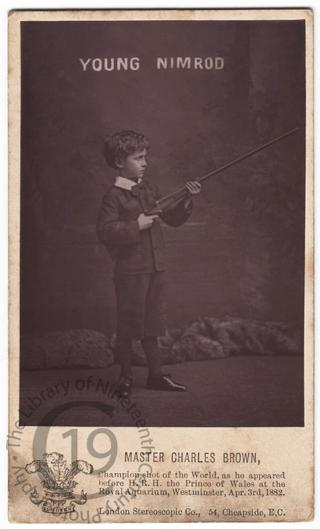
Master Charles Brown ('Young Nimrod')
A carte-de-visite portrait of sharpshooter Master Charles Brown, billed as ‘Young Nimrod’ when he appeared at the Royal Aquarium in 1882.
Born at Nunhead in Surrey in 1874, he appears on the 1881 census living with his parents Thomas Conrad Simmons Brown and Mary Ann née Fisher at the Railway Tavern on Lausanne Road in Camberwell, where his grandfather, also Charles Brown, was the licensed victualler. Charles senior had formerly been a signalman on the railways, according to Thomas and Mary Ann’s marriage certificate (1863). According to one Internet source, Thomas was the proprietor of the South London Shooting Ground at Nunhead, which explains the origins of his son’s prowess with a rifle.
Between March and May 1882 young Charles Brown appeared as a marksman at the Royal Aquarium in Westminster, where the Central Methodist Hall now stands. According to one review: ‘In the variety entertainment on the central stage a boy, who, according to the programme, is only some seven years of age, excited a deal of interest. This child, who is termed “Young Nimrod, the juvenile shot of the world,” certainly exhibited marvellous skill and precision with the rifle’ (Morning Post, 15 May 1882). The Prince of Wales attended an exhibition of glass ball shooting on 3 April 1882.
His stage career appears to have been a short one. I can find no mention of any subsequent engagements of a theatrical nature. However, according to Basil Tozer’s Practical Hints on Shooting (London, 1887) young Charles continued to astound audiences at sporting events for several more years. ‘The boy’s unerring aim, added to his cool, calm demeanour whilst shooting, would do credit to any veteran sportsman – not to mention a child of nine.’ On 25 January 1883 he shot ’70 pigeons out of a 100, at 18 yards rise and 80 fall, using his 28-bore Greener,’ a feat he matched at the Union Club in Hendon later that year. On 2 March 1884 he managed to pierce 60 out of 100 wooden balls ‘with a .380-bore rifle, standing at 10 yards rise, the balls were thrown up by hand in front of him.’ According to Tozer, however: ‘Young Nimrod’s finest performance took place at Nunhead on 25 May 1885, when he broke 1047 glass balls in one hour, the first hundred being disposed of in six minutes fifty seconds.’
By the time the census was taken in 1891 Charles’s parents Thomas and Mary Ann had taken over as publicans at the Railway Tavern. [Lausanne Road had been renamed Gibbon Road in the interim.] Charles, now 17, was living there with them, along with a brother and two sisters. Thomas died a few months later, on 10 June 1891, leaving a personal estate valued at £1,510. His widow carried on as sole proprietor. She was still there in 1911, as was Charles, now aged 37. Mary Ann died two years later, on 8 February 1913.
Photographed by the London Stereoscopic Company.
Code: 126765




